Mutationism
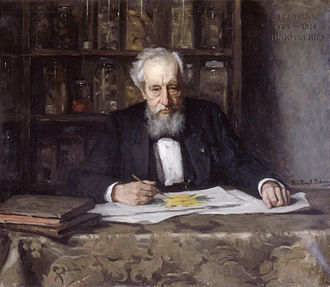
Mutationism is one of several
Before Darwin, biologists commonly believed in
Understanding of mutationism is clouded by the mid-20th century portrayal of the early mutationists by supporters of the modern synthesis as opponents of Darwinian evolution and rivals of the biometrics school who argued that selection operated on continuous variation. In this portrayal, mutationism was defeated by a synthesis of genetics and natural selection that supposedly started later, around 1918, with work by the mathematician Ronald Fisher. However, the alignment of Mendelian genetics and natural selection began as early as 1902 with a paper by Udny Yule, and built up with theoretical and experimental work in Europe and America. Despite the controversy, the early mutationists had by 1918 already accepted natural selection and explained continuous variation as the result of multiple genes acting on the same characteristic, such as height.
Mutationism, along with other alternatives to Darwinism like Lamarckism and orthogenesis, was discarded by most biologists as they came to see that Mendelian genetics and natural selection could readily work together; mutation took its place as a source of the genetic variation essential for natural selection to work on. However, mutationism did not entirely vanish. In 1940, Richard Goldschmidt again argued for single-step speciation by macromutation, describing the organisms thus produced as "hopeful monsters", earning widespread ridicule. In 1987, Masatoshi Nei argued controversially that evolution was often mutation-limited. Modern biologists such as Douglas J. Futuyma conclude that essentially all claims of evolution driven by large mutations can be explained by Darwinian evolution.
Developments leading up to mutationism
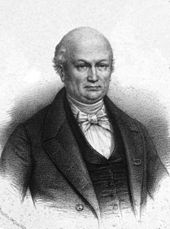
Geoffroy's monstrosities, 1822
Prior to
In 1822, in the second volume of his Philosophie anatomique, Étienne Geoffroy Saint-Hilaire endorsed a theory of saltational evolution that "monstrosities could become the founding fathers (or mothers) of new species by instantaneous transition from one form to the next."[6] Geoffroy wrote that environmental pressures could produce sudden transformations to establish new species instantaneously.[7]
Darwin's anti-saltationist gradualism, 1859
In his 1859 book On the Origin of Species, Charles Darwin denied saltational evolution. He argued that evolutionary transformation always proceeds gradually, never in jumps: "natural selection acts solely by accumulating slight successive favourable variations, it can produce no great or sudden modification; it can act only by very short steps". Darwin continued in this belief throughout his life.[8]
Thomas Henry Huxley warned Darwin that he had taken on "an unnecessary difficulty in adopting Natura non facit saltum ["Nature does not take leaps"] so unreservedly."[9] Huxley feared this assumption could discourage naturalists (catastrophists) who believed that major leaps and cataclysms played a significant role in the history of life.[10]
von Kölliker's heterogenesis, 1864
In 1864
Galton's "sports", 1892
Darwin's cousin, Francis Galton, considered Darwin's evidence for evolution, and came to an opposite conclusion about the type of variation on which natural selection must act. He carried out his own experiments and published a series of papers and books setting out his views. Already by 1869 when he published Hereditary Genius, he believed in evolution by saltation. In his 1889 book Natural Inheritance he argued that natural selection would benefit from accepting that the steps need not, as Darwin had stated, be minute. In his 1892 book Finger Prints, he stated directly that "The progress of evolution is not a smooth and uniform progression, but one that proceeds by jerks, through successive 'sports' (as they are called), some of them implying considerable organic changes; and each in its turn being favoured by Natural Selection".[13]
From 1860 to 1880 saltation had been a minority viewpoint, to the extent that Galton felt his writings were being universally ignored. By 1890 it became a widely held theory, and his views helped to launch a major controversy.[14][15]
Bateson's discontinuous variation, 1894
William Bateson's 1894 book Materials for the Study of Variation, Treated with Especial Regard to Discontinuity in the Origin of Species marked the arrival of mutationist thinking, before the rediscovery of Mendel's laws.[16] He examined discontinuous variation (implying a form of saltation[17]) where it occurred naturally, following William Keith Brooks, Galton, Thomas Henry Huxley and St. George Jackson Mivart.[17]
Early 20th century mutationism
De Vries and Mendelian mutationstheorie, 1901
The main principle of the mutation theory is that species and varieties have originated by mutation, but are, at present, not known to have originated in any other way. — Hugo de Vries[18]
large-scale genetic changes capable of producing a new subspecies, or even species, instantaneously.[1]
The historian of science Betty Smocovitis described mutationism as:[2]
the case of purported
De Vries set out his position, known as Mutationstheorie (mutation theory) on the creative nature of mutation in his 1905 book Species and Varieties: their Origin by Mutation.[23] In the view of the historian of science Edward Larson, de Vries was the person largely responsible for transforming Victorian era saltationism into early 20th century mutation theory, "and in doing so pushed Darwinism near the verge of extinction as a viable scientific theory".[24]
Johannsen's "pure line" experiments, 1903
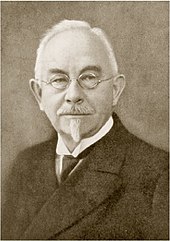
In the early 1900s, Darwin's mechanism of natural selection was understood by believers in continuous variation, principally the
Punnett's mimicry, 1915
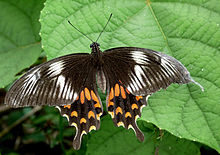
In 1915, Reginald Punnett argued in his book Mimicry in Butterflies that the 3 morphs (forms) of the butterfly Papilio polytes, which mimic different host species of butterfly, demonstrated discontinuous evolution in action. The different forms existed in a stable polymorphism controlled by 2 Mendelian factors (genes). The alleles of these genes were certainly discontinuous, so Punnett supposed that they must have evolved in discontinuous leaps.[31]
The undermining of mutationism
Yule's analysis of Mendelism and continuous variation, 1902
The undermining of mutationism began almost at once, in 1902, as the statistician
Nilsson-Ehle's experiments on Mendelian inheritance and continuous variation, 1908
The Swedish geneticist
Similar work in America by
Castle's selection experiments on hooded rats, 1911
Starting in 1906, William Castle carried out a long study of the effect of selection on coat colour in rats. The piebald or hooded pattern was recessive to the grey wild type. He crossed hooded rats with the black-backed Irish type, and then back-crossed the offspring with pure hooded rats. The dark stripe on the back was bigger. He then tried selecting different groups for bigger or smaller stripes for 5 generations, and found that it was possible to change the characteristics way beyond the initial range of variation. This effectively refuted de Vries's claim that continuous variation could not be inherited permanently, requiring new mutations. By 1911 Castle noted that the results could be explained by Darwinian selection on heritable variation of Mendelian genes.[40]
Morgan's small Mendelian genes in Drosophila, 1912
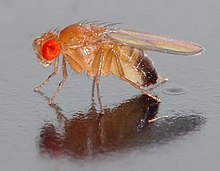
By 1912, after years of work on the genetics of Drosophila fruit flies, Thomas Hunt Morgan showed that these animals had many small Mendelian factors on which Darwinian evolution could work as if variation was fully continuous. The way was open for geneticists to conclude that Mendelism supported Darwinism.[41][42]
Muller's balanced lethal explanation of Oenothera "mutations", 1918
De Vries's mutationism was dealt a serious if not fatal blow in 1918 by the American geneticist Hermann Joseph Muller. He compared the behaviour of balanced lethals in Drosophila with De Vries's supposed mutations in Oenothera, showing that they could work the same way.[43] No actual mutations were involved, but infrequent chromosome crossovers accounted for the sudden appearance of traits which had been present in the genes all along.[44]
Fisher's explanation of polymorphism, 1927
In 1927, Fisher explicitly attacked Punnett's 1915 theory of discontinuous evolution of mimicry. Fisher argued that selection acting on genes making small modifications to the butterfly's phenotype (its appearance) would allow the multiple forms of a polymorphism to be established.[39]
Later mutationist theories
The understanding that Mendelian genetics could both preserve discrete variations indefinitely, and support continuous variation for natural selection to work on gradually, meant that most biologists from around 1918 onwards accepted natural selection as the driving force of evolution.[45] Mutationism and other alternatives to evolution by natural selection did not however vanish entirely.[46][47][48]
Berg's nomogenesis, 1922
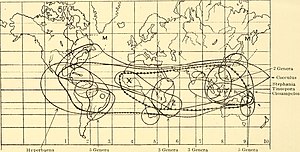
Willis's macromutations, 1923
In 1923, the botanist John Christopher Willis proposed that species were formed by large mutations, not gradual evolution by natural selection,[50][51] and that evolution was driven by orthogenesis, which he called "differentiation", rather than by natural selection.[47]
Goldschmidt's hopeful monsters, 1940

In his 1940 book The Material Basis of Evolution, the German geneticist Richard Goldschmidt argued for single-step speciation by macromutation, describing the organisms thus produced as "hopeful monsters". Goldschmidt's thesis was universally rejected and widely ridiculed by biologists, who favoured the neo-Darwinian explanations of Fisher, J. B. S. Haldane and Sewall Wright.[48][53] However, interest in Goldschmidt's ideas has reawakened in the field of evolutionary developmental biology.[54][55][56][57][58]
Nei's mutation-driven evolution, 1987
Contemporary biologists accept that mutation and selection both play roles in evolution; the mainstream view is that while mutation supplies material for selection in the form of variation, all non-random outcomes are caused by natural selection.[59] Masatoshi Nei argues instead that the production of more efficient genotypes by mutation is fundamental for evolution, and that evolution is often mutation-limited.[52][60][61][62] Nei's book received thoughtful reviews; while Wright[63] rejected Nei's thinking as mistaken, Brookfield,[64] Galtier,[65] Weiss,[66] Stoltzfus,[52] and Wagner,[59] although not necessarily agreeing with Nei's position, treated it as a relevant alternative view.
Contemporary approaches
Reviewing the history of macroevolutionary theories, the American evolutionary biologist
Cases of mutation bias are cited by mutationism advocates of the extended evolutionary synthesis who have argued that mutation bias is an entirely novel evolutionary principle. This viewpoint has been criticized by Erik Svensson.[74] A 2019 review by Svensson and David Berger concluded that "we find little support for mutation bias as an independent force in adaptive evolution, although it can interact with selection under conditions of small population size and when standing genetic variation is limited, entirely consistent with standard evolutionary theory."[75] In contrast to Svensson and Berger a 2023 review by Arlin Stoltzfus and colleagues concluded that there is strong empirical evidence and theoretical arguments that mutation bias has predictable effects on genetic changes fixed in adaptation.[76]
Historiography
Biologists at the start of the 20th century broadly agreed that evolution occurred, but felt that the mechanisms suggested by Darwin, including natural selection, would be ineffective. Large mutations looked likely to drive evolution quickly, and avoided the difficulty which had rightly worried Darwin, namely that blending inheritance would average out any small favourable changes.[d][78] Further, large saltatory mutation, able to create species in a single step, offered a ready explanation of why the fossil record should contain large discontinuities and times of rapid change.[79]
These discoveries were often framed by supporters of the mid-20th century
A more recent view, advocated by the historians Arlin Stoltzfus and Kele Cable, is that Bateson, de Vries, Morgan and Punnett had by 1918 formed a synthesis of Mendelism and mutationism. The understanding achieved by these geneticists spanned the action of natural selection on
Historians have interpreted the history of mutationism in different ways.[80][86][26][87]The classical view is that mutationism, opposed to Darwin's gradualism, was an obvious error; the decades-long delay in synthesizing genetics and Darwinism is an "inexplicable embarrassment";[88] genetics led logically to the modern synthesis and mutationism was one of several anti-Darwinian "blind alleys" separate from the main line leading from Darwin to the present.[89] A revisionist view is that mutationists accepted both mutation and selection, with broadly the same roles they have today, and early on accepted and indeed offered a correct explanation for continuous variation based on multiple genes, paving the way for gradual evolution. At the time of the Darwin centennial in Cambridge in 1909, mutationism and
See also
Notes
- macromutation and saltation are essentially equivalent descriptions.[3]
- ^ Orthogenesis, possibly vitalism.
- ^ The changes in the evening primrose were later shown to be caused by chromosome duplications (polyploidy) rather than gene mutation.[19]
- ^ Mendelian inheritance, with discrete alleles, solves Darwin's problem, as blending does not occur.[77]
References
- ^ ISBN 978-0-8018-4391-4.
- ^ a b c Smocovitis 1996, p. 56.
- ISBN 978-0-14-026408-1.
- ^ Osborn, Henry Fairfield (1894). From the Greeks to Darwin: An outline of the development of the evolution idea. Macmillan. pp. 228–250.
- ^ Bowler 1989, p. 83.
- ISBN 978-0-12-088777-4.
- ^ Bowler 2003, p. 127.
- ^ Darwin, Charles (1859). On the Origin of Species (PDF). p. 471.
- ^ Thomas Henry Huxley. (1859). Letter to Charles Darwin. Archived 2008-01-31 at the Wayback Machine Nov. 23, 1859.
- ^ Gould, Stephen J. (1977). "The Return of Hopeful Monsters". Natural History. 86 (24): 30.
- ISBN 978-0226910383.
- ^ Provine 2001, p. 24
- ^ Provine 2001, pp. 14–24
- ISBN 978-0226702247.
- S2CID 145540549.
- ^ Bateson, William (1894). Materials for the Study of Variation, Treated with Especial Regard to Discontinuity in the Origin of Species. Macmillan.
- ^ PMID 11779782.
- ^ De Vries, Hugo (1922). "Age and Area and the Mutation Theory". In Willis, J. C. (ed.). Age and Area. A Study in Geographical Distribution and Origin of Species. Cambridge University Press. p. 222.
- ^ Endersby 2007, pp. 202–205.
- ^ De Vries, Hugo (1901–1903). Die mutationstheorie. Vol I and II [The Mutation Theory]. Von Veit, Leipzig. Part 2, 1903
- S2CID 83752035.
- ^ Bowler 2003, p. 276.
- ^ De Vries, Hugo (1905). Species and Varieties: Their Origin by Mutation. The Open Court Publishing Company, Chicago.
- ^ Larson 2004, p. 128.
- ^ Provine 2001, pp. 92–100.
- ^ S2CID 170325857.
- S2CID 24783737.
- ^ Bowler 2003, pp. 265–270.
- Kongelige Danske Videnskabernes Selskabs Forhandlinger, vol. 3: 247–270 (in Danish). German ed. Erblichkeit in Populationen und in reinen Linien [On inheritance in populations and in pure lines] (1903) Gustav Fischer, Jena. Scanned full text. Archived 2009-05-30 at the Wayback Machine
- ^ Johannsen, W. L. (1905). Arvelighedslærens elementer [The elements of heredity] (in Danish).
- ^ Punnett, Reginald C. (1915). Mimicry in Butterflies. Cambridge University Press.
- .
- ^ a b Provine 2001, pp. 81–82.
- ^ Nilsson-Ehle, H. (1908). "Einige Ergebnisse von Kreuzungen bei Hafer und Weizen" [Observations on Crosses in Oats and Wheat]. Botaniska Notiser (in German): 257–294.
- ^ Provine 2001, pp. 114–118.
- S2CID 85340555.
- ^ Provine 2001, pp. 118–120.
- S2CID 181213898.
- ^ a b Provine 2001, pp. 140–154
- ^ Provine 2001, pp. 109–114.
- ^ Provine 2001, pp. 120–121.
- ^ Allen 1968, pp. 113–139.
- PMID 17245914.
- ^ Provine 2001, pp. 121–122.
- ^ Bowler 2003, pp. 307–308.
- ^ a b Levit, Georgy S.; Olsson, Lennart (2006). "'Evolution on Rails' : Mechanisms and Levels of Orthogenesis" (PDF). Annals of the History and Philosophy of Biology (11): 112–113.
- ^ doi:10.1086/281018.
- ^ ISBN 978-0300028232.
- .
- .
- doi:10.1086/334994.
- ^ .
- ^ Ruse 1996, pp. 412–413.
- ^ Theissen, Guenter (2010). "Homeosis of the angiosperm flower: Studies on three candidate cases of saltational evolution" (PDF). Palaeodiversity. 3 (Supplement): 131–139.
- S2CID 13372946.
- ^ Judson, Olivia. (2008). The Monster Is Back, and It's Hopeful. The New York Times.
- PMID 20164895.
- PMID 20584293.
- ^ PMC 3814208.
- PMID 17513888.
Unlike neo-Darwinism, which regards mutation as merely raw material and natural selection as the creative power, Nei's mutationism assumes that the most fundamental process for adaptive evolution is the production of functionally more efficient genotypes by mutation (especially birth and death of duplicated genes) and by recombination.
- ^ Nei's works on this topic include:
- ISBN 978-3-540-12903-5.
- ISBN 978-0231063210.
- PMID 17640887.
- PMID 16120807.
- ISBN 978-0199661732.
- S2CID 19619966.
- PMID 24673244.
- .
- .
- PMC 3852927.
- ^ )
- ISBN 978-1-4612-8227-3.
- S2CID 163847899.
- S2CID 163866832.
- S2CID 85008221.
- ^ Minelli, A. (2010) "Evolutionary developmental biology does not offer a significant challenge to the neo-Darwinian paradigm". In: Ayala, F. J.; Arp, R. (eds) Contemporary debates in philosophy of biology. Wiley, Chichester, pp 213–226
- S2CID 28316833. Archived from the original(PDF) on 2017-08-29.
- ISBN 978-3-031-22027-2.
- S2CID 125066709.
- PMID 37004719.)
{{cite journal}}: CS1 maint: multiple names: authors list (link - ^ Bowler 1989, p. 210.
- ^ Larson 2004, p. 121.
- ^ Larson 2004, pp. 127–129, 157–167.
- ^ a b Provine 2001, pp. 56–107.
- ^ S2CID 10469049.
- ISBN 978-0521841146.
- ^ a b Smocovitis 1996, pp. 1–65.
- S2CID 23263558.
- ^ Bateson, William; Saunders, E. R. (1902). "Experimental Studies in the Physiology of Heredity". Royal Society. Reports to the Evolution Committee. Archived from the original on 2020-04-23. Retrieved 2017-08-23.
- PMID 24811736.
- ^ Gayon 1988, pp. 289 and passim.
- ISBN 978-0691633657.
- ^ Bowler 1989, pp. 276–281.
- ^ Tax, S.; Callender, C., eds. (1960). Evolution After Darwin: The University of Chicago Centennial. University of Chicago Press, Chicago.
Sources
- Allen, Garland E. (1968). "Thomas Hunt Morgan and the problem of natural selection". Journal of the History of Biology. 1 (1): 113–139. S2CID 84932356.
- Bateman, Richard M.; DiMichele, William A. (2002). Generating and Filtering Major Phenotypic Novelties, NeoGoldschmidtian Saltation Revisited. In Cronk, Q. C. B.; Bateman R. M.; Hawkins J. A. eds. Developmental Genetics and Plant Evolution. London: Taylor and Francis. pp. 109–159.
- ISBN 978-0-520-23693-6.
- ISBN 978-0-520-06386-0.
- Bateson, William. (1894). Materials for the Study of Variation: Treated with Especial Regard to Discontinuity in the Origin of Species. Macmillan.
- Endersby, Jim (2007). A Guinea Pig's History of Biology. Harvard University Press. ISBN 978-0-674-02713-8.
- Gayon, J. (1988). Darwinism's Struggle for Survival: Heredity and the Hypothesis of Natural Selection. Cambridge University Press.
- ISBN 9781588365385.
- Provine, W. B. (2001). The Origins of Theoretical Population Genetics, with a new afterword. University of Chicago Press, Chicago.
- ISBN 978-0-674-03248-4.
- Smocovitis, Vassiliki Betty (1996). Unifying Biology: The Evolutionary Synthesis and Evolutionary Biology. Vol. 25. Princeton, New Jersey: Princeton University Press. pp. 1–65. )
